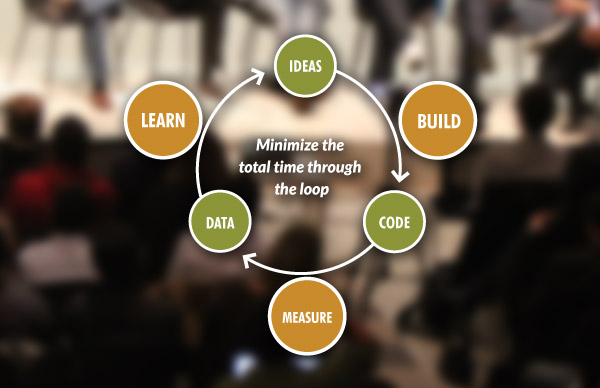
How to Effectively Manage Your Client-Partner Relationships
Clients Project StrategyClients leave when they feel that their needs aren’t being met. The strength of your client-partner relationship relies on a deep understanding of your client’s...
I recently attended the The Lean Startup New York Conference, an event that brings together entrepreneurs and corporate innovators who seek to learn about innovation and sustainable growth using the Lean Startup methodology.
Eric Ries’ methodology of building and growing a company, codified in The Lean Startup (2011), has caught on rapidly among tech entrepreneurs and established companies with a digital product portfolio. Many speakers and participants at the conference came from well-known companies—such as Etsy, Microsoft, GE, and The New York Times—providing many perspectives and examples of implementing Lean Startup within existing enterprises. More on that in a second.
At a very high level, The Lean Startup argues that the best way to build a product is to:

The aim of The Lean Startup is to work efficiently through the cycle, in order to waste as little time and money in the effort to build the right product. For more reading on the methodology, visit The Lean Startup.
And back to the takeaways. Here are four in particular that I gleaned from this year’s conference:
Carefully consider the companies I listed above. Again, many attendees were from large, established organizations. None of them are startups. What is it about The Lean Startup that these types of companies find attractive?
I hypothesize that enterprises are fighting to stay relevant and become nimble. Maybe they think behaving like a tech startup will bring them success like that of Lyft and Airbnb. In other words, it could be the necessity to adapt to a rapidly iterative business landscape that attracts enterprises to this entrepreneurial model of growth. What I’ve seen from enterprise employees is that they are hungry for new and creative ways of engaging their customers for the present and the future. While they might not be startup entrepreneurs, I was encouraged to see their desire to further their knowledge, learn from others, and improve the way they operate within their companies.
The bottom line is this: large companies that are willing to experiment and trial-and-error new ways of growing, building digital products and engaging their customers are more likely to remain relevant.
Speaking of a willingness to experiment, multiple speakers explained the importance of a company’s leadership to allow for experimentation. Let’s take a step back. The Lean Startup’s rapid build-measure-learn approach requires that leadership trust their employees’ rapid execution on new ideas and initiatives on behalf of their companies. Even better are leaders who take charge and require self-motivated employees seek new opportunities for company growth. How can leaders do this? Adopt the Lean Startup approach in management!
The Lean Startup model encourages leaders to allow employees to find ways of growing the company (meaning: generating revenue!) without fear. For more on this, I strongly recommend reading Jeff Bezos’ 2016 Letter to Shareholders where he touches upon his “disagree-and-commit” approach to leadership.
The term “minimum viable product” (MVP) really took off due to Eric Ries’ book. It has since become a used-and-abused term in the technology industry and most people not familiar with the Lean Startup definition probably have some mutated understanding of what it means. Indeed, even at Big Nerd Ranch, we throw the word around with casual flair.
However, we must go back to what minimum viable product actually is, and why its definition is critical to growing a prudent business:
A minimum viable product contains the least amount of code to achieve the most amount of validated learning.
An MVP is not a poorly-executed first version of the product. Nor is it what you think is the first set of features required to get success. Rather, an MVP is designed for learning, period. An MVP is built to validate or invalidate pre-determined metrics based on a set of assumptions about the product’s potential market. An MVP tells you whether your metrics are validating your assumptions correctly, or whether you need to go back to the drawing board.
Whether developers are part of a small or large company, it is imperative that they know their customers. At the conference, developers were given a potent warning: either intimately know how your customers feel about and use your products, or watch your products fail. This does not mean reading aggregated surveys or a summative report on market trends. It means actively engaging with your customers face-to-face, whether in person or through video.
Why the importance of face-to-face interaction? Because there’s a lot of meaning and context in facial expression, body movement and conversational tone that gets lost when reading surveys. When designers and product managers are interviewing current and future customers, developers should absolutely join in on the research by assisting or taking the lead in the interviewing process. Leaving it up to others to know how customers engage with their product makes developers far less effective at making positive impact. So when designers and product managers are improving on understanding their users, developers might maximize their output by asking, “Can I help you?”
The Lean Startup has proven to intrigue both entrepreneurs and enterprises. At Big Nerd Ranch, we apply Lean Startup principles to building products for startup entrepreneurs, leveraging build-measure-learn approaches to minimum viable products. We do the same thing for our enterprise clients, ensuring that we waste as little time and budget as possible. How can you apply these takeaways to your own business and development process?

Clients leave when they feel that their needs aren’t being met. The strength of your client-partner relationship relies on a deep understanding of your client’s...

Responding to change is a key tenant of Agile Software Development. Predicting change is difficult, but software can be developed in a manner that...

A lot of this confusion surfaces around the scope of machine learning. While there is a lot of hype around deep learning, it is...